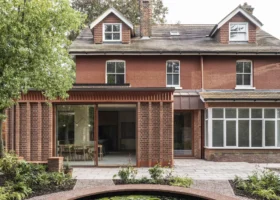

Restoring an old fireplace is a sure-fire way to add charm to a home. If you’re renovating a property built in the 1950s or earlier, there is a high likelihood that there will be an opening for a fire at the base of any chimneybreast, or an opening for a back boiler, gas or electric fire on later properties.
It might be that you’ve got a covered up fireplace that you didn’t even know was there. Telltale signs that there could be one tucked away include the presence of a chimneybreast, a chimney on the roof or a stone hearth on the floor (which can be raised or flush, so check under the carpet). Also look in the loft for the presence of a chimney and how many flues run into it.
If you suspect an opening behind a wall, a knock test is a good, basic starting point. Simply knock on the wall and listen for a hollow sound which indicates a void and potential to restore an old fireplace.
“On homes which have been replastered, it’s usually pretty easy to find the vertical opening sides by looking at signs like skirting widths or where the floor tiles of the hearth are positioned,” says property renovation expert and founder of Make It Moregeous, Sian Astley. “To find the opening height, look at the wall from the side and run your hand over the wall. Often the ridge of where new meets old plaster can be seen or felt. This line can even tell you whether there’s a straight horizontal top, or an arch.”
Restoring an old fireplace will usually involve multiple stages of work, from recreating or enlarging the opening to installing a new hearth and flue liner. Some projects are more DIY-friendly than others, but as Building Regulations apply, people often farm out the whole project and find a local retailer-cum-installer for their chosen appliance.
Either way, a slow and gentle approach is best when restoring an old fireplace, minimising any damage. If bricks are to be removed, a bolster chisel and hammer will cause less unintentional damage than a sledgehammer, while a plasterboard covering will be more straightforward to take off. Both will create a lot of dust so ensure sheeting is laid. It is common to find soot and rubble within the opening which will need to be cleared out. What you uncover during this phase will dictate next steps.
Undertaking a renovation project? Read our essential guide to the 10 Renovation Mistakes to Avoid
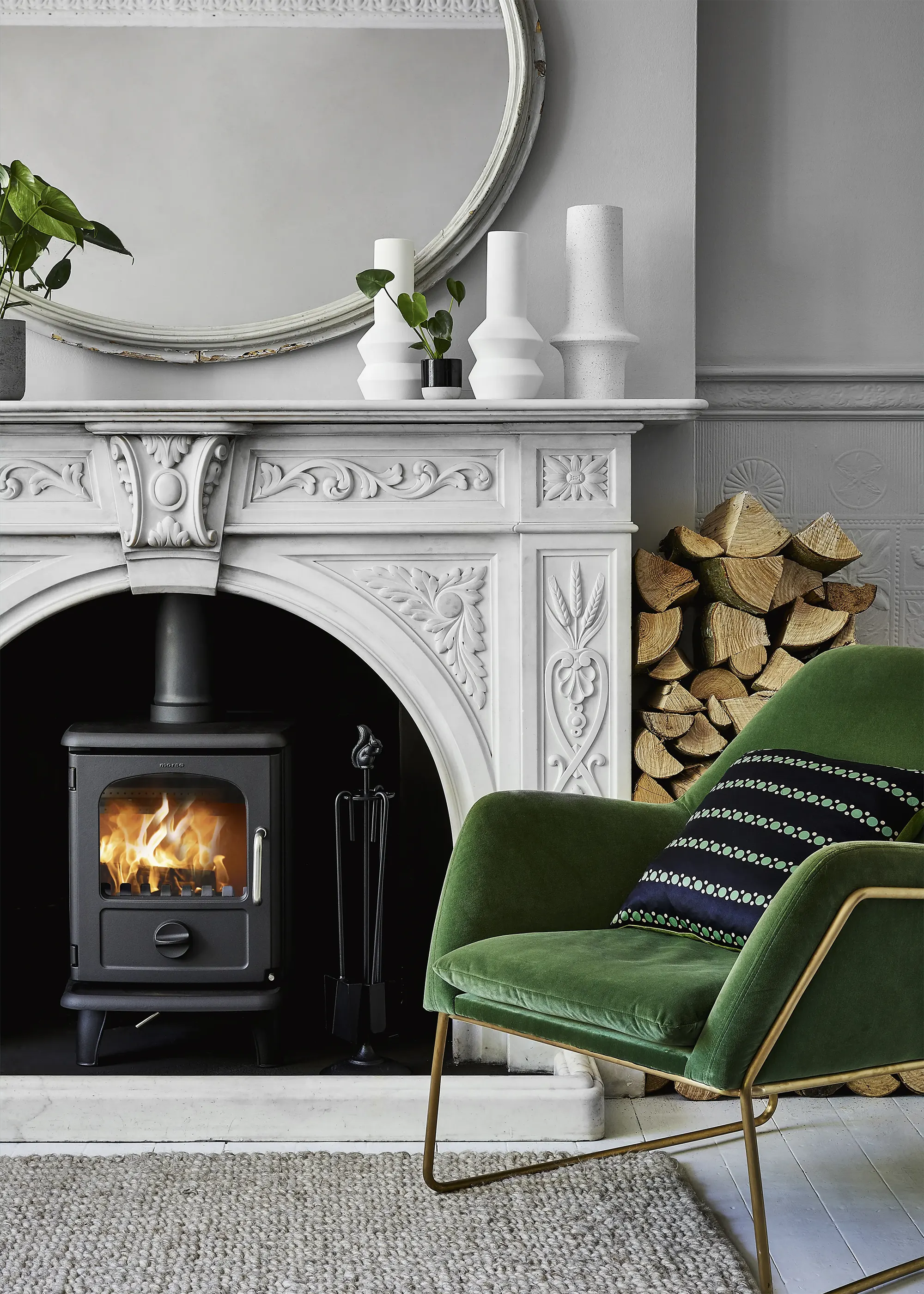
The Morso 3112 5kW stove features a classic design combined with the latest combustion technology, including a tertiary air supply, to achieve great performance. It can heat areas of up to 75m3
Structurally, a fireplace opening will typically be self-supporting, but issues can arise when mortar has perished over time, meaning that repointing may be required. A flat top opening may also need to be reinforced with a new lintel or angle iron.
Take advice from a builder – generally, a structural engineer will only be required if a substantial part of the chimneybreast is to be removed. “When a fireplace is covered, a ventilation brick is typically installed to prevent damp,” says Thomas Goodman, property and construction expert at Myjobquote.co.uk. “Remove this and, using a torch, look inside to see how deep the aperture goes. Hold a flame next to the hole: if it is drawn into the space, this indicates an updraft and a potential working chimney.”
Your Questions Answered: Installing a gas fire in an existing fireplaceAlexander Sheldon from Stovax & Gazco answers your frequently asked questions about installing a new gas fire in an existing or old fireplace. Q) What are the benefits of choosing a modern gas fire over other heating options in an existing property?Modern gas fires blend the traditional warmth and aesthetic appeal of wood fires with ultimate convenience. With their instant ignition, no prep required such as gathering wood or clearing up ash, and remote-control functionality, they’re effortlessly manageable. Plus, with balanced flue systems eliminating the need for a chimney, they can provide a fantastic solution for chimneyless homes or where an existing chimney is unsuitable for use. Q) Are there any requirements for installing a gas fire in an existing fireplace?All conventional flue gas fires need a chimney, just like a real woodburner does. But balanced flue gas fires open up your options. They feature a twin-wall pipe that terminates through an exterior wall. The outer pipe is used for air intake, whilst the inner removes combustion gases. Above: Shown is the Riva2 600HL Edge gas fire Q) Who should install your new gas fire?It is essential that your gas fire is installed by a Gas Safe installer, as they will ensure your manufacturer’s instructions and industry regulations are adhered to. From considering ventilation to installing the product with the correct distance to combustibles, there are numerous considerations that require a qualified professional to undertake the work. Your expert retailer may be able to carry out the work or put you in contact with a recommended qualified person. Alexander Sheldon is gas product development manager at Stovax & Gazco. He has been an expert in his field at Stovax & Gazco for 12 years and is also a technical expert on the European Standards Technical Committee for gas fired space heaters. |
If you wish to use the opening as a heating source, a qualified chimney sweep or HETAS-certified fire installer should be engaged to consult on the type and condition of the chimney and deal with any blockages, such as birds nests.
They’ll use a flexible inspection camera to check. “In virtually all cases apart from electric fires, a chimney liner is installed that, in effect, remedies any issues with the internal structure of the chimney. In the past, many chimneys were used without liners, leading to tar and resin build up or cracks within the internal clay pot sections. A suitable metal liner will remedy this,” says Niall Deiraniya, UK general manager at DRU Fires.
“A chimney must have pull (natural draught) and this usually means adding extra internal ventilation to aid the flow through of air.”
Thinking about installing a wooburning stove in your restored fireplace? Read more: Woodburning Stoves: Your Guide to Choosing & Installing Woodburners
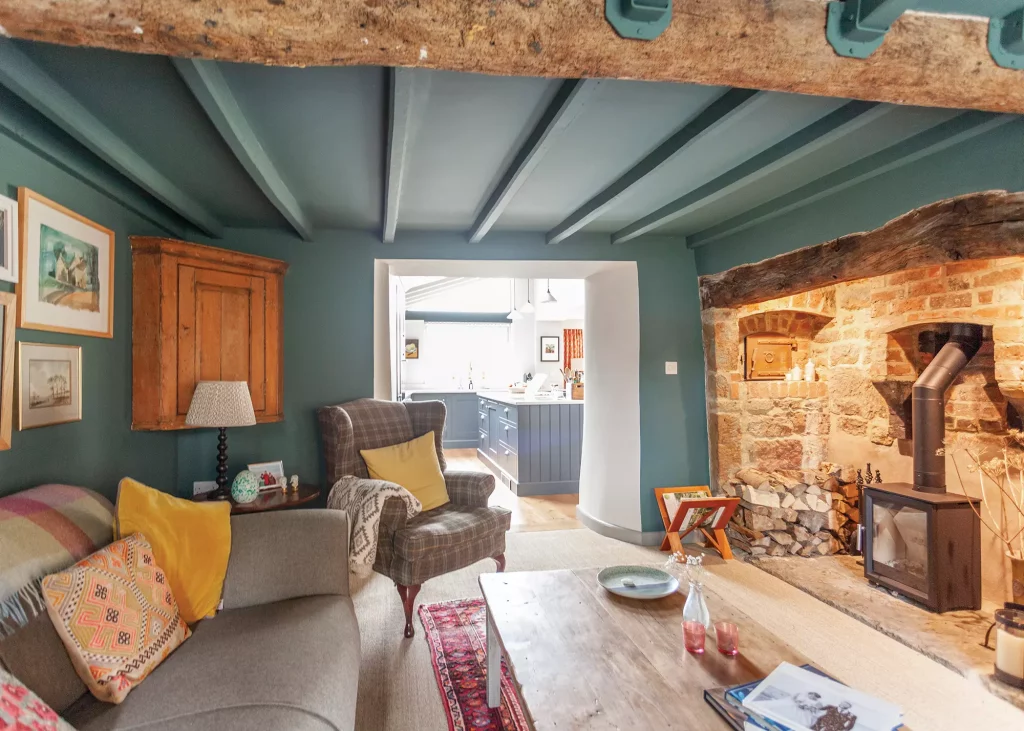
As part of their period cottage renovation, Martin and Julie Smart restored the old bread oven that sat in the home’s inglenook. The couple have installed a 5kW woodburner, and stone flags reclaimed from the building work form the hearth. Photo: William Goddard
Familiarise yourself with the flue type, as this will impact heating options. A site assessment will be able to tell you which type of heating option you should look to install and the fuel you’re able to burn after you’ve fully restored the old fireplace. “Your local retailer will arrange a site assessment. They’ll be able to check whether the chimney is in good condition, or whether it might need lining to get it into working order,” says Dave Saunders from Stovax.
This typically involves a smoke test to establish whether there are gaps in masonry joins or damaged flue pipes. If significant leaks are happening, a new flue will be needed.
“A Class 1 is a traditional type of chimney typically built from brick or stone and is suitable for use with solid fuel fires such as wood or coal,” explains Thomas. “Class 2 flues are pre-cast, made of either concrete or metal, and are not suitable for solid fuel fires or fully inset gas fires. They can be used with a radiant gas fire, semi-inset living flame or outset living flame fires.”
A pre-cast flue can be found on most modern houses and is suitable for electric, slimline gas fires or stoves. Power flues, typically mounted on an external wall, allow homes without a chimney to have open-front gas fires.
Once suitability is determined and the opening cleaned, swept and lined, decide on the heating system you want: wood, gas or electric.
Seek out heating suppliers who can advise on the product choices and options available to suit your room’s size and ventilation requirements. It’s a good idea to consult with your local authority to check whether your property is located within a Smoke Control Area for solid fuel, and to confirm compliance with Building Regulations – particularly part J, which focuses on air supply, flue provision and ensuring a safe install.
More Ideas: Modern Stove and Fireplace Designs for Your Project
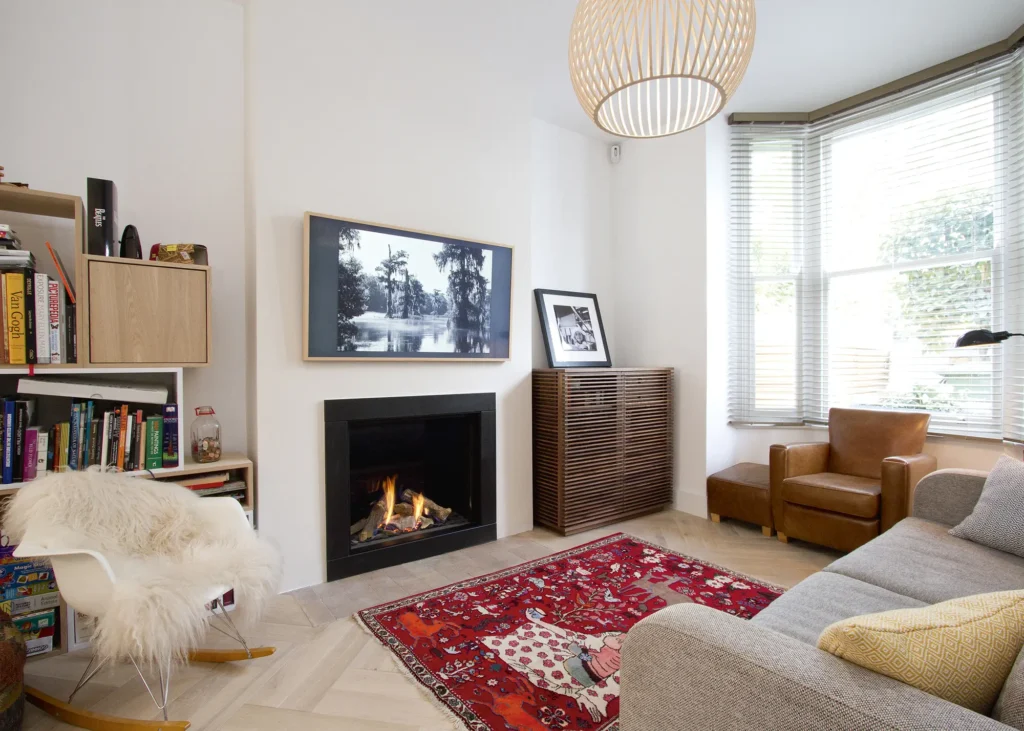
The DRU Maestro 75 gas fire was installed in this North London townhouse within an existing fireplace opening. This model uses external air for combustion which is recirculated through a concentric flue, resulting in greater efficiency
A good heating supplier should register any new appliance with building control for you. For a replacement gas fire, you must use a Gas Safe-registered engineer for installation (including any work done to pipes). An electrician can fit a new electric fire, in which case the chimney will not be needed and can be safely sealed.
CASE STUDY Adding a stove into an existing fireplaceIn search of a real log burner to accentuate her home’s traditional but timeless style, Anna Jennings opted for a Stovax Vogue medium woodburning and multi-fuel stove, set within an existing fireplace. Installed by Miles Chimney Services in Worcestershire, the stove is sited within a chimneybreast that previously sat flush to the wall internally. To add character and interest to the living room, this was extended with a false chimneybreast, complete with a limestone surround in keeping with the interior scheme. The inside of the opening was then tiled and a hearth installed to match the surround. The property was built in the early 2000s with an external chimney, but the new stepped chimneybreast and stylish surround create a timeless focal point. “It has that lovely balance of a traditional stove but with a contemporary feel. The huge glass window makes it for us, and we love to watch the fire roar in the evening. It’s perfect in our space,” says Anna. BEFOREAFTER |
If a dated electric or gas fire is uncovered and you want to keep it, a thorough service should be carried out before any use. In most cases, the preferred option is to upgrade to a modern solution that is much more energy efficient.
“Today’s electric fires are far more advanced, have thermostats, high resolution LED technology, comply with stringent safety tests and are extremely cheap to run. With anything electric, over time its integrity will diminish and it is far better to start again than persevere with something old, unsafe and expensive to run,” says Niall.
Of course, it’s up to you if you use your newly uncovered fireplace for heating or not – either way, it will create a lovely centrepiece. If you’re renovating a period home, it is possible to find original surrounds, such as Victorian cast iron designs which are often inlaid with detailed ceramic tiles.
If you’re lucky enough, you may uncover a marble or limestone surround or mantle that can be brought back to life by a stonemason. A professional restorer will use techniques such as sandblasting to remove old paint and polishing. These treatments are costly so it’s always worth getting an estimate before committing. If you’re restoring an old fireplace yourself, establish what the surround is made from so you use the right products to get it back to its original condition.
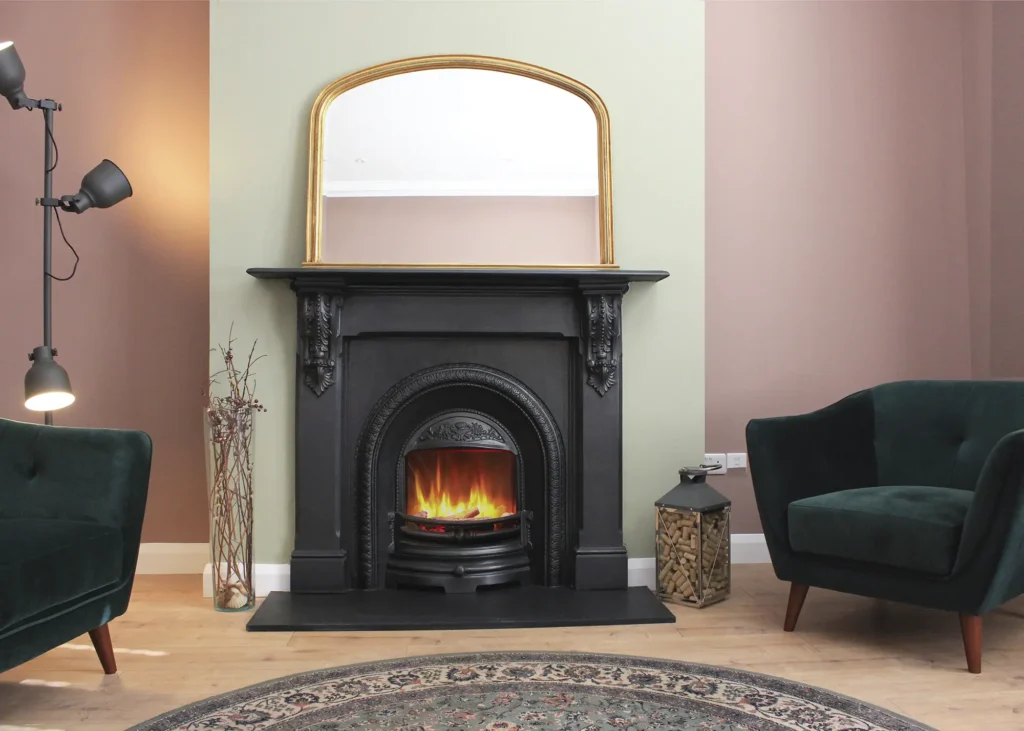
Ideal if you’re looking for a traditional style, perhaps consider an electric fire but with period features. Shown here is the Iconic Lombard 450 fireplace with electric fire from Eurostove
If you want a bare-brick fireplace with no mantel – a clean, minimal setting for a woodburning stove – don’t expect to find perfect brickwork lining the original opening. It’s often a mess, using offcut bricks and rough mortar, because it was intended to be covered with a fireback.
Slotting in a made-to-measure brick-faced chamber will restore a neat finish – but many opt to render it, or line it with a non-combustible board.
If you like the look of an open fire in a traditional setting but want efficiency, too, look for gas fires with a glass screen that completely covers the aperture, which can be paired with a period mantel.
“For a cast iron fireplace, clean off any old paint or plaster and make any repairs. Once it is in good shape again you can apply a specialist cast iron polish. Limestone or marble fire surrounds will require delicate cleaning and specialist products to renovate them as they are both porous materials,” says Thomas.
You can have the chimney closed off to prevent draughts and heat loss, and use the opening as a decorative focal point instead. Tiling, log piles, candles, lanterns or even books can provide a stylish alternative to a typical stove. If you’d like the look of a fire, consider an LED fire screen which achieves this without any heat output.
Essential Advice: Installing a Stove or Fire in an Existing Home
This article was originally published in January 2018 and has been updated in March 2024. Additional Content by Lindsay Blair.
